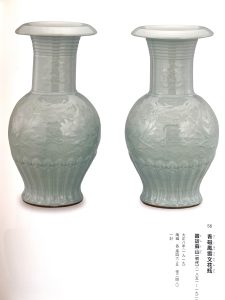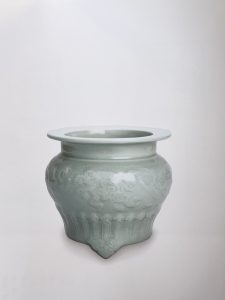帝室技芸員 初代諏訪蘇山(愛知県名古屋市千種区姫池通 骨董買取 古美術風光舎)
2024.07.25
みなさまこんにちは、スタッフYでございます。
先日から時々ブログにて少しずつ取り上げております 帝室技芸員。
昨年10月に石川県美術館にて行われました「皇居三の丸尚蔵館収蔵品展 皇室と石川」を訪れ、その際、帝室技芸員の作品を一度にたくさん鑑賞できたのですが、訪れた当初は感動し、お腹いっぱいといったところでした。そんなわけで思わず購入した図録を今頃思い出して眺めているのですが、図録を読み返していると「なるほど、そうなんだ。」といった新たな知識と感動したあの時の印象が今頃結びついてき、いろいろ噛み締めているところであります。
本日は、そんな中印象に残っております石川県生まれの帝室技芸員、陶工 初代諏訪蘇山についてご紹介いたします。
まずは、展覧会で鑑賞しました2作品を。

青磁鳳雲文花瓶
「皇居三の丸尚蔵館収蔵品展 皇室と石川」図録より

青磁鳳雲文花香炉
「皇居三の丸尚蔵館収蔵品展 皇室と石川」図録より
初代諏訪蘇山(1851-1922)は明治~大正の陶芸家、金沢生であります。名は好武、別号に金水堂、精斎など。当初、加賀藩で武芸を学び軍務に携わるのですがのちに離職。任田徳次(彩雲楼旭山)に陶画法を学んで陶画業を始めます。その後、九谷陶器会社、石川県工業学校などに勤めてその後京都の錦光山製陶場に招かれます。
明治40年には独立。五条坂に開窯し、青磁、白磁、彩磁のほか窯変の法など釉薬の研鑽に努め、特にその青磁は「蘇山青磁」と称され彼の作品の特徴となっていきます。
画像ではその「蘇山青磁」をうまくお伝え出来ないのが誠に残念でありますが、透き通った艶のあるその淡青色に引き込まれ、自分が溶けていくような感覚になったような記憶が今も残っています。
蘇山の青磁作品はその淡青色の美しい色調とともに、精緻な造形や装飾が特徴的。蘇山は中国南宋時代の龍泉釜の砧青磁を探求し、胎土の研究も併せておこない、土に色をつけることでより理想に近い青磁を再現していきますが、その精緻な造形・装飾に欠くことの出来ない技が石膏型を用いた成形技法です。これにより蘇山は精緻な造形・装飾と高い再現性(量産性)を両立するのですが、近年その胴部の石膏型が発見され、本作の一部が型で造られたことが明確になりました。造形と装飾を同時に適える方法として、石膏型は優れており、これにより蘇山は早い時期から石膏型を駆使しいたことがうかがえ知れます。
そんな彼は、大正15年(1917)「蘇山の青磁が中国宋時代の青磁に真に迫っていた」という評価で帝室技芸員に任命されており、これらの二作品は共に帝室技芸員に任命後の蘇山へ宮内庁から特別注文されたものであります。
失敗を許されない作品制作。この薄青色の青磁に吸い込まれるような印象が今でもしっかり残っているのは、蘇山が自身の最高技術で応えた気迫のようなものが自分にも伝わってきたからでしょうか。
それにしても、なんと表現するのがふさわしいのか、ずっと言葉を探したくなる薄青色が今でも忘れられない2作品でありました。
それではごきげんよう。
Hello everyone, this is Staff Y.
Since the other day, I have been writing a little bit about Imperial Household Artists in my blog.
Last October, I visited “The Imperial Household and Ishikawa” at the Ishikawa Prefectural Museum of Art, where I was able to see many works by Imperial Household Artists at one time. I was so impressed that I bought the catalogue and now I am looking at it, and when I read it again, I was impressed by the new knowledge I gained. I am now looking at the catalogue I bought without thinking, and as I read it over again, new knowledge such as “I see, I see,” and the impressions I had at that time come together, and I am now chewing on various things.
Today, I would like to introduce Suwa Suzan I, a potter born in Ishikawa Prefecture and a member of the Imperial Household Artists’ Association, who left a deep impression on me.
First, I would like to introduce two pieces that I saw at the exhibition.
Celadon glazed vase with phoenix cloud design
From the catalogue of the exhibition “The Imperial Household and Ishikawa,” from the collection of the Imperial Palace San-no-Maru Shōzōkan
Celadon glazed incense burner with phoenix cloud design
From the catalogue of “The Imperial Household and Ishikawa: Exhibition of the Collections of the Imperial Household Museum” (Japanese only)
Suwa Suzan I (1851-1922) was a ceramic artist of the Meiji and Taisho periods. He was born in Kanazawa. His name was Yoshitake, and his other names included Kinsuido and Seisai. He initially studied martial arts in the Kaga Clan and served in the military, but later left the service. He studied pottery painting under Noda Tokuji (Saiunro Kyokusan) and began his career as a ceramic painter. After that, he worked at the Kutani Pottery Company and the Ishikawa Prefectural Industrial School before being invited to work at the Nishikozan Pottery in Kyoto.
In 1907, he became independent. He opened a kiln on Gojozaka and studied celadon, white porcelain, and colored porcelain, as well as glazes, such as the method of kiln transformation, and his celadon in particular is known as “Suzan celadon,” a characteristic of his work.
It is truly regrettable that I cannot show you the “Su Shan celadon” well in the picture, but I remember that I was drawn into the clear, glossy, pale blue color and felt as if I were melting away.
Su Shan’s celadon works are characterized by their exquisite molding and decoration as well as their beautiful pale blue color. He reproduced celadon porcelain more closely resembling the ideal by adding color to the clay, and the molding technique using plaster molds is indispensable for his exquisite modeling and decorations. The plaster molding technique is an indispensable technique for the exquisite molding and decoration of celadon porcelain. Plaster molds are excellent as a method to simultaneously achieve modeling and decoration, and it is evident that Sosan made full use of plaster molds from his early period.
In 1917, he was appointed as a member of the Imperial Household Artists for his reputation that “Su Shan’s celadon porcelain was truly close to the celadon porcelain of the Sung dynasty in China.
The production of these works was a process that allowed no room for failure. I still have a strong impression of being absorbed by this pale blue celadon, perhaps because I was able to feel the spirit with which Suyama responded with his best techniques. I still cannot forget the pale blue color of these two works, which makes me want to keep searching for words to describe them.
I will leave you with my best wishes for the future.
*******************
ご実家の整理やお片付けなどをされている方のご相談などが多くございます。
お片付けなどくれぐれもご無理のないようになさってくださいませ。
風光舎では古美術品や骨董品の他にも絵画や宝石、趣味のお品など様々なジャンルのものを買受しております。
お片付けをされていて、こういうものでもいいのかしらと迷われているものでも、どうぞお気軽にご相談下さいませ。
また風光舎は、出張買取も強化しております。ご近所はもちろん、愛知県内、岐阜県、三重県その他の県へも出張いたします。
まずは、お電話お待ちしております。
愛知県名古屋市千種区姫池通
骨董 買取【古美術 風光舎 名古屋店】
TEL052(734)8444
10:00-18:00 OPEN
#出張買取#骨董#古美術#骨董品#絵画#版画#茶道具#刀剣#彫刻

